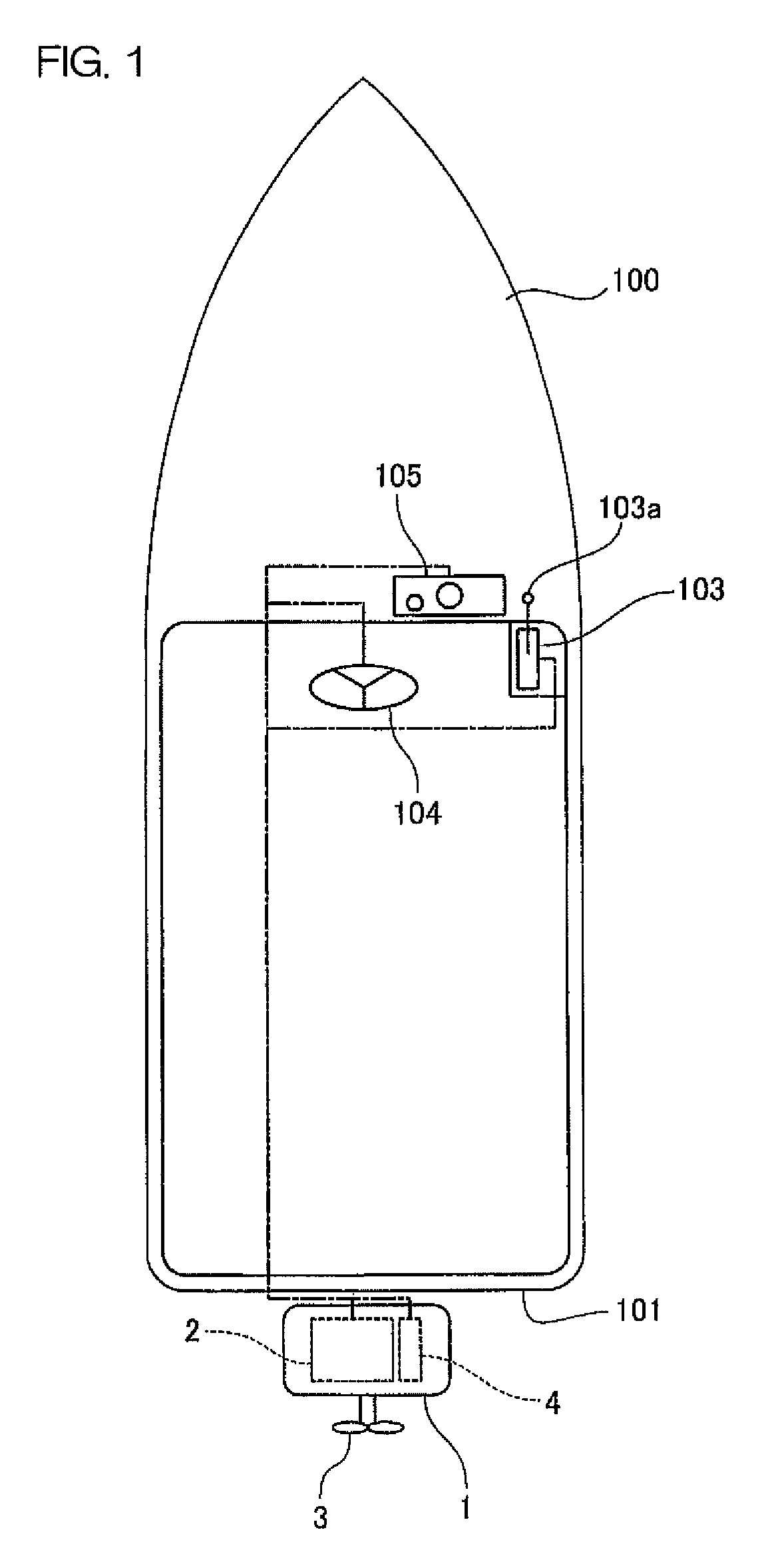Marine vessel propulsion device and marine vessel including the same
a technology for propulsion devices and marine vessels, applied in the direction of vessel construction, automatic control, instruments, etc., can solve the problems of large loads being applied to parts of the shift drive unit and the shift mechanism unit, and the misfiring is started from a subsequent spark plug
- Summary
- Abstract
- Description
- Claims
- Application Information
AI Technical Summary
Benefits of technology
Problems solved by technology
Method used
Image
Examples
first preferred embodiment
FIG. 1 is a schematic plan view of an overall configuration of a marine vessel that includes an outboard motor according to a first preferred embodiment of the present invention. In the present preferred embodiment, an outboard motor 1, which is one example of a marine vessel propulsion device, is attached to a stern 101 of a hull 100. The outboard motor 1 includes an engine 2, a propeller 3 arranged to be rotated by a driving force of the engine 2, and a forward-reverse switching mechanism unit 4. In addition, the propeller 3 and the forward-reverse switching mechanism unit 4 are, respectively, one example of a “thrust generating unit” and one example of a “shift mechanism unit” according to a preferred embodiment of the present invention.
A remote control apparatus 103, a steering apparatus 104, and a display unit 105 are installed at a central portion of the hull 100. The remote control apparatus 103 is arranged to be operated by a user to command a throttle opening of the engine ...
second preferred embodiment
FIGS. 6 and 7 are, respectively, a flowchart and a timing chart for explaining an operation of controlling the engine and the forward-reverse switching mechanism unit by the ECU of an outboard motor according to a second preferred embodiment of the present invention. The structures of the marine vessel and the outboard motor according to the second preferred embodiment preferably are the same as those of the first preferred embodiment shown in FIGS. 1 to 3. Also, the flowchart of FIG. 6 differs from the flowchart of FIG. 4 in that step S12 is carried out between step S3 and step S4.
In the second preferred embodiment, the lag time period (predicted lag time period) from the point in time when the misfire control is started to the point in time when the misfiring is actually started is computed (predicted). In the second preferred embodiment, after starting the misfire control in step S3, the ECU 5 computes the lag time amount based on the engine speed at the point in time when the mi...
third preferred embodiment
FIG. 8 is a timing chart for explaining an operation of controlling the engine and the forward-reverse switching mechanism unit by the ECU of an outboard motor according to a third preferred embodiment of the present invention. The above described FIG. 6 shall be referred to again in regard to the control operation. Also, the structures of the marine vessel and the outboard motor according to the third preferred embodiment are preferably the same as those of the first preferred embodiment shown in FIGS. 1 to 3.
Unlike in the second preferred embodiment, the ECU 5 determines the ignition timing by using a timer in the third preferred embodiment. Specifically, in the third preferred embodiment, after starting the misfire control in step S3 of FIG. 6, the ECU 5 predicts the maximum lag time amount in step S12 of FIG. 6. That is, the ECU 5 uses the engine speed at the point in time when the misfire control is started, the number of cylinders (for example, four cylinders in the third pref...
PUM
 Login to View More
Login to View More Abstract
Description
Claims
Application Information
 Login to View More
Login to View More - R&D
- Intellectual Property
- Life Sciences
- Materials
- Tech Scout
- Unparalleled Data Quality
- Higher Quality Content
- 60% Fewer Hallucinations
Browse by: Latest US Patents, China's latest patents, Technical Efficacy Thesaurus, Application Domain, Technology Topic, Popular Technical Reports.
© 2025 PatSnap. All rights reserved.Legal|Privacy policy|Modern Slavery Act Transparency Statement|Sitemap|About US| Contact US: help@patsnap.com



